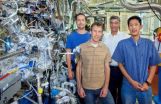(Press-News.org) Optical gyroscopes, also known as rotation sensors, are widely used as a navigational tool in vehicles from ships to airplanes, measuring the rotation rates of a vehicle on three axes to evaluate its exact position and orientation. Prof. Koby Scheuer of Tel Aviv University's School of Physical Engineering is now scaling down this crucial sensing technology for use in smartphones, medical equipment and more futuristic technologies.
Working in collaboration with Israel's Department of Defense, Prof. Scheuer and his team of researchers have developed nano-sized optical gyroscopes that can fit on the head of a pin ― and, more usefully, on an average-sized computer chip ― without compromising the device's sensitivity. These gyroscopes will have the ability to pick up smaller rotation rates, delivering higher accuracy while maintaining smaller dimensions, he says. The research was recently described in the journal Optics Express.
"Conventional gyroscopes look like a box, and weigh two or three pounds," Prof. Scheuer explains. "This is fine for an airplane, but if you're trying to fit a gyroscope onto a smaller piece of technology, such as a cellphone, the accuracy will be severely limited."
With laser precision
At the core of the new device are extremely small semi-conductor lasers. As the devices start to rotate, the properties of the light produced by the lasers changes, including the light's intensity and wavelength. Rotation rates can be determined by measuring these differences.
These lasers are a few tens-of-micrometers in diameter, as compared to the conventional gyroscope, which measures about 6 to 8 inches, says Prof. Scheuer. The device itself, when finished, will look like a small computer chip. Measuring a millimeter by a millimeter (0.04 inches by 0.04 inches), about the size of a grain of sand, the device can be built onto a larger chip that also contains other necessary electronics.
Prof. Scheuer and his team of researchers are currently working on lab demonstrators of the device, which he predicts will be ready for testing in a few years' time.
Tracking inside the body
When available, the nano-gyroscopes will improve technologies that we use every day. When you rotate an iPhone, for example, the screen adjusts itself accordingly. A nano-gyroscope would improve the performance of this feature and be sensitive to smaller changes in position, says Prof. Scheuer. And that's not all. Nano-gyroscopes integrated into common cellphones could provide a tracking function beyond the capabilities of existing GPS systems. "If you find yourself in a place without reception, you would be able to track your exact position without the GPS signal," he says.
There are benefits to medical science as well. Right now, small capsules that contain cameras pass through the body during some diagnostic procedures, but to know where the capsule is within a patient, doctors must track its signal from the outside. With the addition of a nano-gyroscope, explains Prof. Scheuer, the capsule would have a built-in navigation system, which would provide the ability to move the capsule to more specific and precise locations within the body.
###
American Friends of Tel Aviv University (www.aftau.org) supports Israel's leading, most comprehensive and most sought-after center of higher learning. Ranking 94th among the world's top universities for the impact of its research, TAU's innovations and discoveries are cited more often by the global scientific community than all but 10 other universities.
Internationally recognized for the scope and groundbreaking nature of its research and scholarship, Tel Aviv University consistently produces work with profound implications for the future.
A tracking device that fits on the head of a pin
Tel Aviv University develops mini-gyroscopes to guide smartphones and medical equipment
2010-10-06
ELSE PRESS RELEASES FROM THIS DATE:
Better cholesterol drugs may follow Saint Louis University researcher's breakthrough
2010-10-06
ST. LOUIS – Thanks to a discovery by a Saint Louis University researcher, scientists have identified an important microRNA that may allow us to better control cholesterol levels in blood.
Led by Ángel Baldán, Ph.D., assistant professor of biochemistry and molecular biology at Saint Louis University and published in a recent issue of Proceedings of the National Academy of Sciences of the United States of America, the study found that the microRNA miR-33, may be key to controlling HDL, or "good" cholesterol levels.
In the U.S., heart attack, stroke, and peripheral ...
October 2010 issue of the Bulletin of the Seismological Society of America
2010-10-06
Causal relationship between rainfall and earthquakes detailed
This review article explores natural crustal earthquakes associated with the elements of the hydrologic cycle, which describes the continuous movement of water on, above and below the surface of the Earth, including hurricanes and typhoons. The theory of hydroseismicity, first articulated in 1987, attributes most intraplate and near-intraplate earthquakes, to the dynamics of the hydrological cycle.
The Hydroseismicity hypothesis suggests variations in rainfall affect pore-fluid pressure at depth and can ...
Sociologists find lowest-paid women suffer most from motherhood penalty
2010-10-06
WASHINGTON, DC, October 5, 2010 — In a study of earnings inequality among white women, researchers at the University of Massachusetts Amherst find that having children reduces women's earnings, even among workers with comparable qualifications, experience, work hours and jobs. While women at all income levels suffer negative earnings consequences from having children, the lowest-paid women lose the most from motherhood. This earnings penalty ranges from 15 percent per child among low-wage workers to about 4 percent among the highly paid. The findings are published in the ...
Scripps Research scientists shed light on how serotonin works
2010-10-06
JUPITER, FL, October 5, 2010 - Scripps Research Institute scientists have shown for the first time that the neurotransmitter serotonin uses a specialized signaling pathway to mediate biological functions that are distinct from the signaling pathways used by hallucinogenic substances. The new findings could have a profound effect on the development of new therapies for a number of disorders, including schizophrenia and depression.
The study was published in the October 6, 2010 issue of the Journal of Neuroscience.
Serotonin has tremendous influence over several brain ...
New type of liquid crystal promises to improve performance of digital displays
2010-10-06
Chemists at Vanderbilt University have created a new class of liquid crystals with unique electrical properties that could improve the performance of digital displays used on everything from digital watches to flat panel televisions.
The achievement, which is the result of more than five years of effort, is described by Professor of Chemistry Piotr Kaszynski and graduate student Bryan Ringstrand in a pair of articles published online on Sept. 24 and Sept. 28 in the Journal of Materials Chemistry.
"We have created liquid crystals with an unprecedented electric ...
San Diego Supercomputer Center participates in first 'Census of Marine Life'
2010-10-06
After a decade of joint work involving 2,700 researchers from 80 countries, the world's scientists – as well as the general public – can now access the Census of Marine Life, which provides the first in-depth look at the more than 120,000 diverse species which inhabit our oceans.
The Census of Marine Life initiative, started in 2000, is the result of one of the largest scientific collaborations ever conducted , the result of more than 540 expeditions and 9,000 days at sea, plus more than 2,600 academic papers published during that period.
The just-released census paints ...
Fuel cells in operation: A closer look
2010-10-06
Measuring a fuel cell's overall performance is relatively easy, but measuring its components individually as they work together is a challenge. That's because one of the best experimental techniques for investigating the details of an electrochemical device while it's operating is x-ray photoelectron spectroscopy (XPS). Traditional XPS works only in a vacuum, while fuel cells need gases under pressure to function.
Now a team of scientists from the University of Maryland, the U.S. Department of Energy's Sandia National Laboratories, and DOE's Lawrence Berkeley National ...
Neuroscience research may help patients recover from brain injury
2010-10-06
New neuroscience research by life scientists from UCLA and Australia may potentially help people who have lost their ability to remember due to brain injury or disease.
By examining how we learn and store memories, these scientists have shown that the way the brain first captures and encodes a situation or event is quite different from how it processes subsequent similar events.
The study is published in the Sept. 29 edition of the online journal PLoS ONE, a publication of the Public Library of Science.
Memories are formed in the part of the brain known as the ...
AGU journal highlights -- Oct. 5, 2010
2010-10-06
The following highlights summarize research papers that have been recently published in Geophysical Research Letters (GRL), Journal of Geophysical Research-Atmospheres (JGR-D), or Water Resources Research (WRR).
1. Antarctic sea ice increase not linked to ozone hole
While sea ice extent has declined dramatically in the Arctic in recent years, it has increased slightly in the Antarctic. Some scientists have suggested that increased Antarctic sea ice extent can be explained by the ozone hole over Antarctica. Previous simulations have indicated that the ozone hole induces ...
Oldest evidence of dinosaurs found in Polish footprints
2010-10-06
The oldest evidence of the dinosaur lineage—fossilized tracks—is described this week in Proceedings of the Royal Society B. Just one or two million years after the massive Permian-Triassic extinction, an animal smaller than a house cat walked across fine mud in what is now Poland. This fossilized trackway places the very closest relatives of dinosaurs on Earth about 250 million years ago—5 to 9 million years earlier than previously described fossilized skeletal material has indicated. The paper also described the 246-million-year-old Sphingopus footprints, the oldest evidence ...
LAST 30 PRESS RELEASES:
SIMJ announces global collaborative book project in commemoration of its 75th anniversary
Air pollution exposure and birth weight
Obstructive sleep apnea risk and mental health conditions among older adults
How talking slows eye movements behind the wheel
The Ceramic Society of Japan’s Oxoate Ceramics Research Association launches new international book project
Heart-brain connection: international study reveals the role of the vagus nerve in keeping the heart young
Researchers identify Rb1 as a predictive biomarker for a new therapeutic strategy in some breast cancers
Survey reveals ethical gaps slowing AI adoption in pediatric surgery
Stimulant ADHD medications work differently than thought
AI overestimates how smart people are, according to HSE economists
HSE researchers create genome-wide map of quadruplexes
Scientists boost cell "powerhouses" to burn more calories
Automatic label checking: The missing step in making reliable medical AI
Low daily alcohol intake linked to 50% heightened mouth cancer risk in India
American Meteorological Society announces Rick Spinrad as 2026 President-Elect
Biomass-based carbon capture spotlighted in newly released global climate webinar recording
Illuminating invisible nano pollutants: advanced bioimaging tracks the full journey of emerging nanoscale contaminants in living systems
How does age affect recovery from spinal cord injury?
Novel AI tool offers prognosis for patients with head and neck cancer
Fathers’ microplastic exposure tied to their children’s metabolic problems
Research validates laboratory model for studying high-grade serous ovarian cancer
SIR 2026 delivers transformative breakthroughs in minimally invasive medicine to improve patient care
Stem Cell Reports most downloaded papers of 2025 highlight the breadth and impact of stem cell research
Oxford-led study estimates NHS spends around 3% of its primary and secondary care budget on the health impacts of heat and cold in England
A researcher’s long quest leads to a smart composite breakthrough
Urban wild bees act as “microbial sensors” of city health.
New study finds where you live affects recovery after a hip fracture
Forecasting the impact of fully automated vehicle adoption on US road traffic injuries
Alcohol-related hospitalizations from 2016 to 2022
Semaglutide and hospitalizations in patients with obesity and established cardiovascular disease
[Press-News.org] A tracking device that fits on the head of a pinTel Aviv University develops mini-gyroscopes to guide smartphones and medical equipment


